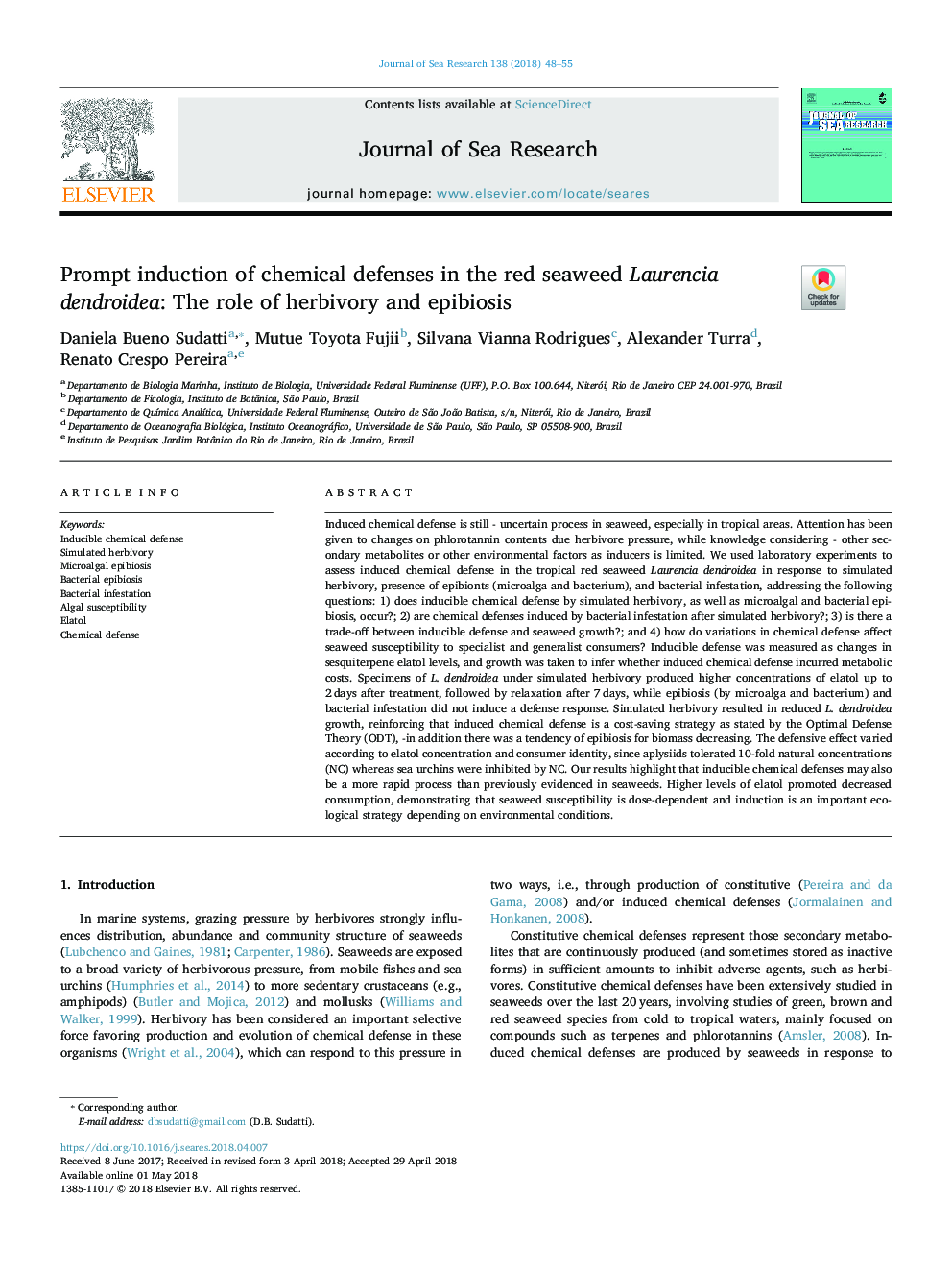| کد مقاله | کد نشریه | سال انتشار | مقاله انگلیسی | نسخه تمام متن |
|---|---|---|---|---|
| 8886107 | 1627437 | 2018 | 8 صفحه PDF | دانلود رایگان |
عنوان انگلیسی مقاله ISI
Prompt induction of chemical defenses in the red seaweed Laurencia dendroidea: The role of herbivory and epibiosis
دانلود مقاله + سفارش ترجمه
دانلود مقاله ISI انگلیسی
رایگان برای ایرانیان
موضوعات مرتبط
مهندسی و علوم پایه
علوم زمین و سیارات
اقیانوس شناسی
پیش نمایش صفحه اول مقاله

چکیده انگلیسی
Induced chemical defense is still - uncertain process in seaweed, especially in tropical areas. Attention has been given to changes on phlorotannin contents due herbivore pressure, while knowledge considering - other secondary metabolites or other environmental factors as inducers is limited. We used laboratory experiments to assess induced chemical defense in the tropical red seaweed Laurencia dendroidea in response to simulated herbivory, presence of epibionts (microalga and bacterium), and bacterial infestation, addressing the following questions: 1) does inducible chemical defense by simulated herbivory, as well as microalgal and bacterial epibiosis, occur?; 2) are chemical defenses induced by bacterial infestation after simulated herbivory?; 3) is there a trade-off between inducible defense and seaweed growth?; and 4) how do variations in chemical defense affect seaweed susceptibility to specialist and generalist consumers? Inducible defense was measured as changes in sesquiterpene elatol levels, and growth was taken to infer whether induced chemical defense incurred metabolic costs. Specimens of L. dendroidea under simulated herbivory produced higher concentrations of elatol up to 2â¯days after treatment, followed by relaxation after 7â¯days, while epibiosis (by microalga and bacterium) and bacterial infestation did not induce a defense response. Simulated herbivory resulted in reduced L. dendroidea growth, reinforcing that induced chemical defense is a cost-saving strategy as stated by the Optimal Defense Theory (ODT), -in addition there was a tendency of epibiosis for biomass decreasing. The defensive effect varied according to elatol concentration and consumer identity, since aplysiids tolerated 10-fold natural concentrations (NC) whereas sea urchins were inhibited by NC. Our results highlight that inducible chemical defenses may also be a more rapid process than previously evidenced in seaweeds. Higher levels of elatol promoted decreased consumption, demonstrating that seaweed susceptibility is dose-dependent and induction is an important ecological strategy depending on environmental conditions.
ناشر
Database: Elsevier - ScienceDirect (ساینس دایرکت)
Journal: Journal of Sea Research - Volume 138, August 2018, Pages 48-55
Journal: Journal of Sea Research - Volume 138, August 2018, Pages 48-55
نویسندگان
Daniela Bueno Sudatti, Mutue Toyota Fujii, Silvana Vianna Rodrigues, Alexander Turra, Renato Crespo Pereira,